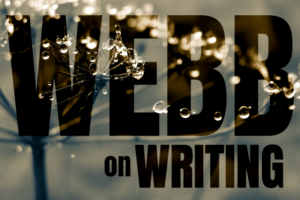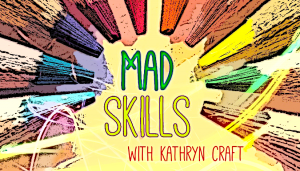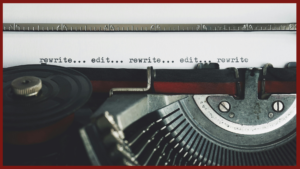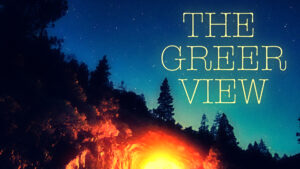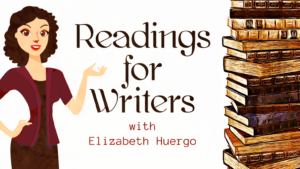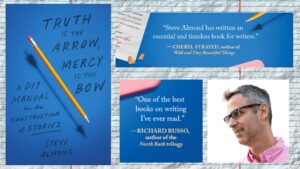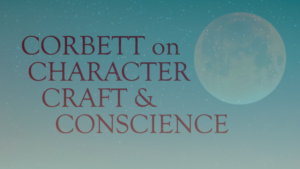Inspirations
Have I said all I need to about craft and the writing life? This is what I asked myself as I searched my mind and heart for a compelling topic to write about. I have literally thought about this post for weeks and kept coming up blank until I realized that was the very thing – this coming up blank – that has plagued my writing life for the past six months. I’d sit at my desk and stare at my WIP, move a few commas around, reread what I’d written, maybe manage to eke out a few sentences, and then walk away. Over and over again, week after week, month after month. It’s been a frustrating year in that regard, and I started doubting the premise of my WIP. Would anyone want to read this book anyway? And then I started doubting myself. Maybe I couldn’t pull off what I was trying to do on the page. Maybe I’d forgotten how to write entirely.
So I’d been paralyzed, so much so, that I’d been stranded at the same 30k word count for months.
I’ve Got Nothin’
Read Morephoto adapted / Horia Varlan
Back when I was an arts journalist, a friend who had just read my latest dance review said to me, “I’m sorry you didn’t like the performance. What a waste of time.”
I had no idea what she was talking about. I couldn’t possibly have written about dance for two decades without believing that every opportunity to engage with art—whether or not I “liked” it—is a growth process. Recognizing this in your own life can be a springboard to leveling up your writing game.
The most enjoyable part of your ongoing education as a novelist is having a tax-deductible reason to get swept into a fully immersive story that suspends time and leaves an aftertaste of revelation. Now, though, you’re reading for two. For your inner writer, any warm, fuzzy feelings that remain after closing a novel’s back cover will be secondary to a higher goal: what you might learn from the story, even if it disappointed you.
So before you unwittingly echo some version of the refrain, “I wasted good money/ten hours of my time on this book that I’ll never get back,” consider leaving that complaint to those readers who never push themselves to grow. Writers benefit from reading widely. Period.
Let me count the ways—six of them, anyway, as I’m sure there are more—that you can move a disappointing novel from the “I didn’t like it” column to the “This book was a good teacher” column. I’ve organized the list by complaints that, on the surface, seem justifiable.
1. I refuse to finish—I have to watch what writing I pour into my brain.
To inspire my own novel writing, I tend to read fiction that is more literary than my own. Such image-rich craft jump-starts my imagination and ensures that I’ll stretch to the limits of my capacity. And yet my teaching and developmental editing require that I am conversant with a range of published material along the commercial-to-literary continuum—one can’t expect everyone to write like Toni Morrison. Author Katherine Center (The Rom-Commers) even stopped setting that expectation for herself when she left behind her MFA-inspired literary projects to embrace the contemporary romances that shot her onto the New York Times bestseller list.
To honoring both inner reader and writer, I no longer set aside a novel before asking myself what lessons it has to offer. Why did this story fail to engage me? Why couldn’t I relate to this protagonist? What prose patterns ground on my nerves? What weighed down story movement to the point that setting the novel aside occurred to me in the first place?
2. But it was a New York Times bestseller!
We’ve all heard writers claim that their oft-rejected novel is better-written than the bestseller they just finished. That may well be true. But that disappointing read from the list still has much perspective to offer writers about the industry they hope will one day support them. The hardest lesson is this: Publishing is not a meritocracy. It’s commerce.
These days, it’s rare to find a title that was elevated to the list due to a growing, merit-based swell. Bestsellers are now “made” through advance campaigns publishers employ to safeguard profits […]
Read MoreMy dad, Grant Overstake, has written millions of sentences. As a former journalist, pastor, and now novelist, he’s got what the writing world considers “chops.” Big papers like the Miami Herald published his sports column for years, and small papers had his by-line on every article from op-eds to sports to obits.
His young adult sports novels are precise, beautiful, engaging. His sermons, spoken word he wrote to help rural Kansans navigate their faith journeys and complicated lives in the late 90s, were captivating, heart-felt, well-rounded. This man has done it all in the writing world — if I listed his awards, I’d reach my word-limit in this article.
I decided early in my life that I, too, would be a writer. If you’re a parent and you try to get your kid to find passion in the things you love, you likely will feel one of two things: the sting of rejection accompanying an eye-roll, or the wave of pride accompanying an attempt. My first attempt was verbal storytelling, just like my dad behind the pulpit. It turned into written storytelling as soon as I could hold a pen. Sign me up, Dad! I wanted to be like him.
Sometimes, a sign-me-up attitude can be intimidating as a parent. What if your child is no good? What if they’re not coachable? What if criticism of them is too much? I don’t know what form of bravery swept me as a child, but I showed my award-winning journalist father my first attempt at a novel, written in a wide-ruled spiral-bound notebook.
“Don’t overwrite,” he said. “Simplify it. Here, read this.” And he handed me Hemingway, Herman Hesse, and Rick Reilly.
In high school, he read my articles for the school paper and with his bracing, left-handed scrawl, edited with no hesitation. I remember, at first, that it stung. I might’ve cried. I was fifteen, learning from a master. I worked harder, read more closely, listened carefully. I built my words on the true stories from a small-town high school where football reigned supreme. In this world, the girls on the sidelines weren’t writing articles; they were dressed in cheer uniforms, caught up in the spectacle rather than the storytelling.
I donned a cheer uniform, too, and learned and listened to how sports were played. I wrote for myself, for my classes, for my newspaper, for essay contests. I sought my dad’s praise, his admiration, his subtle nod that affirmed I’d done it right. I won some of my own awards.
I had to learn, from an amazing writer, how to accept what a first draft is: each sentence might change. Bones are there, meat needs to fill in around it. Simpler is better. Red ink is strengthening your work. None of this is personal – these words are not tattooed on you. Nothing is permanent until the paper’s put to bed, kid. I remember the smell of newsprint, the dusting of ink on the sides of his hands, his press badge on the kitchen counter, his fingers calloused with the grip of a pencil.
I learned how to accept his red ink […]
Read More
Once upon a time, there was a contest that asked people to write a novel in three days.
(The Three-Day Novel Contest still exists, actually – I looked it up, and it takes place annually over Labor Day weekend! A little late to get started for this year.)
National Novel Writing Month (NaNoWriMo) is one thing—generating a complete first draft in one month, as thousands of people attempt every November—but the three-day novel (https://www.3daynovel.com) is a whole different ball of wax.
To generate a 50K-word first draft in a month, your pace is 1667 words per day.
To do the same in three days instead of thirty? 16,667 words.
(Assuming you write 20 hours of each day for three days, which would be insane but also maximize your writing time, that’s 833 words per hour. Writing 17 hours a day leaves more time for sleep, but ups your hourly count to 980 words each hour. Good luck, y’all!)
The fast first draft isn’t for everyone, and the three-day novel definitely isn’t. But as a writer who loves to pour on the speed when circumstances allow, and someone who produces an insanely messy first draft even when I take my time and write slowly, I find that setting a blistering pace is absolutely the best way for me to get a big chunk of that first draft on the page.
If you want to give it a shot, here are my three favorite guidelines for putting the most words on the page as quickly as possible.
(Three-day novel not guaranteed.)
Set goals, but don’t obsess. Yes, you’re trying to get to a certain number on a certain schedule. Yes, it will probably help you focus if you chunk up the goal into smaller pieces (10K before dinner on Day 1, 35K before bed on Day 2, etc.) But getting obsessed with hitting those goals precisely will mess with your head and your productivity. And if you set out to write 50K words in three days and you only get to 30K? That’s still 30K words you didn’t have before! Congratulations.
Generate without judgment, but don’t cheat. There are ways to crank up your word count without generating text that has a chance of making it into the finished novel. When I officially entered the Three-Day Novel Contest back in the early 2000s, I definitely did things I knew didn’t make sense for a finished novel. I included song lyrics. Encyclopedia entries. I had my protagonist, a college professor, walk across his campus and think about every building he saw. These are not things that make for riveting reading. In a second draft, they would come out anyway. Try to minimize them in your first draft, even when you’re going for speed. (But if you type something and later think, I shouldn’t have included that, do NOT go back and delete. We are not deleting here. That’s not how this works.)
Start early, but don’t start from scratch. There is a very specific moment in a novel’s development when I can write a thousand words in an hour […]
Read MoreTherese here to introduce you to someone near and dear to me: my son, Liam. ❤️
Liam’s screenwriting journey started as a Rod Serling fan. Inspired by Serling’s allegorical storytelling, he attended USC’s film school where his thesis film, You Missed a Spot, was selected in over 30 festivals internationally. Since then, he has worked on the production-side of the industry, most recently wrapping as the line producer’s assistant on FX’s Mayans MC.
You may have heard about the downturn of work in Hollywood, and so Liam has bided his time between jobs doing something he was likely, inevitably, genetically born to do: WRITE. That the short story he’s written, that he’s now determined to see produced (see Kickstarter), taps into a real-life wound should come as no surprise to you, WU community.
But I’ll let Liam tell you about that, WU-style. Take it away, kiddo.
As writers, we often face the challenge of crafting stories that feel authentic, especially when venturing into experiences we haven’t lived ourselves. This was the case for me when I set out to write my new short film, Venus in Furs, a psychological thriller that personifies heroin as a woman.
I’m a filmmaker living in Los Angeles, and my life was deeply impacted when one of my close friends from film school overdosed on drugs laced with the powerful synthetic opioid, fentanyl. I remember the first time I met him—we were attending a mandatory lecture on the cinema and music of the 1960s. We were sitting on either side of another student we both had a crush on and got into a pointless debate about The Doors, as if this poor girl remotely cared about some band from five decades ago. He demolished me in the debate. The guy was like Jim Morrison himself—long-haired, charismatic as hell, with a ribcage you could practically see through his t-shirt.
After the girl successfully escaped, the two of us grabbed lunch and admitted we were only trying to impress her. Instant friendship.
During lunch, our conversation abruptly ended when he mentioned he was going to leave to smoke some opium. I assumed he was joking at the time—I mean, I had just met the guy. What, opium? You mean that shit from the 1800s? But over time, I came to learn that he was affected by a powerful addiction that, to him, wasn’t some unshakable affliction as often depicted, but rather the means to radically take hold of his post-high-school freedom and live out the fantasy of the rock ’n’ roll lifestyle he so loved.
The last time I saw him, I visited his three-bedroom high-rise in Downtown Los Angeles, full of vintage records and a collection of Les Pauls paid for with credit cards he couldn’t pay off. It was the Fourth of July, and he was excited to launch fireworks at passing cars. At that point, I had witnessed the drug obliterate his ambitions. He had stopped attending classes, gained weight, and lost that magic spark that drew me to him in the first place. Heroin took everything from him. And yet he was so happy to participate in his own self destruction. In fact, sitting there with all his guitars and […]
Read More
In 2016, when the film Manchester by the Sea was released, I went to see it with a friend. The movie, directed by Kenneth Lonergan, tells the story of a reclusive, down-and-out janitor, played by Casey Affleck, who has lost his children in a house fire caused by his own negligence. Depressed and antisocial, he’s forced back into the land of the living after the sudden death of his brother, when he becomes the legal guardian of his teenage nephew.
Although the movie was sad, it spoke volumes about our ability as individuals to overcome almost unbearable circumstances, grounding and humanizing the sort of horrendous catastrophe that is all too often politicized or used to boost ratings by the mainstream media.
As my friend and I were walking out to the car after the movie, my friend said, “If I’d known how depressing that was going to be, I would have stayed home.”
I didn’t mention it at the time, but I loved Manchester by the Sea. I wasn’t the only one. The film was nominated for six Academy Awards and won two: Best Actor and Best Screen Play.
In Poetics, Aristotle’s famous essay on Greek drama, he wrote that the purpose of tragedy is to “arouse sensations of pity and fear, and to purge [the audience] of these emotions so that they leave the theater feeling cleansed and uplifted, with a heightened understanding of the ways of gods and men.”
Anyone who enjoys listening to the blues knows how this works. It’s also the reason that some of the most revered and beloved works of literature in the English language are tragedies.
Because they offer insight into the human condition, often exhibit circumstances that foster societal plight, and promote critical thinking, tragedies were once standard curriculum in high school and college English classes.
In the late 1980s, when I was in high school, we read Shakespeare’s Othello, Hamlet, Macbeth, and Julius Caesar.
As freshmen, we cringed and wrung our hands after learning the fate of Thomas Hardy’s Tess, the protagonist of his masterwork, Tess of the d’Urbervilles. Poor Tess never had much of a chance.
My sophomore year, we spent a week discussing the suicide of Willy Loman, the sad-sack anti-hero of Arthur Miller’s Death of a Salesman.
I’ll never be able to forget Melville’s luckless Billy Bud, hanged by his neck from the yardarm for a crime he didn’t commit, or the murder of Jay Gatsby, F. Scott Fitzgerald’s lovesick millionaire, shot to death in his own swimming pool.
These works of literature and others like them can be tough to get through. But, in my opinion at least, the cultural, ethical, and spiritual enlightenment tragedies offer outweighs any emotional burden they might impart.
And yet, sometime over the last thirty or so years, tragedies fell out of favor. Novels like Of Mice and Men and The Scarlet Letter make up a large percentage of the books that have been banned in certain parts of the country. Perhaps this is a result of the general backlash against anything even remotely intellectual that’s run rampant in the U.S. for the past few decades, […]
Read MoreWhen I sat down to write thie post, I started by checking my definitions. The first definition the search engine brought up for turbulent was this: ‘characterized by conflict, disorder, or confusion; not stable or calm.’ Apt for the world of today? Most certainly. The second definition related specifically to air or water: ‘moving unsteadily or violently’. That is appropriate right now in my part of the world, where a storm is blowing in from the ocean, with wild winds and heavy rain making their presence known outside my study window, not to mention the booming thunderclaps that make my little dog tremble with fear, while her stone-deaf brother sleeps through it all. Storm sounds do make a change from the buzz and screech of power tools outside that same window, where my neighbour and his friends are working almost daily on the gradual restoration of a neglected old house. A house where a man died a lonely death. I’m surrounded by stories here.
As the rain pelts down outside, I’ve been writing a scene in which a character risks his life to rescue crew members from a sinking boat, with the assistance of porpoises. There is indeed turbulence, both in the water and in the mind and body of the rescuer, not to speak of those whose lives are in jeopardy. In a different scene, a character uses a forest pool for scrying (seeking wisdom in visions) and sees snatches of the boat rescue on the water’s surface. She knows the rescuer, who is far away. Finding the deeper meaning in such visions requires calmness of mind. That calm may be hard to find if you’ve just seen someone you care about on the verge of drowning. So there’s inner turbulence for this character also.
In many earth-based faiths the elements of earth, air, fire and water play a part in ritual practice, and are significant in the way we view the world and our fellow creatures. Water, for instance, can both life-giving and, in times of storm or flood, destructive, as shown in traditional stories from many parts of the world. Perhaps, in our writing, we draw on both the peaceful and the turbulent. We may find that dichotomy in the world beyond the window and also in ourselves.
Are my choices as a writer influenced by the world outside my window? Of course they are, even though I’m writing a fantasy novel set in a far-off place, in an earlier time, combining real world elements with pure invention. Everything in our lives is fuel for storytelling. The world outside our window, and the wider world beyond, is almost certain to play some part in what we write and how we do it. Even if your characters are not human, it’s your observation of human (or animal) behaviour that helps you shape them into something real and compelling on the page. A writer may choose to set aside the big issues confronting the world right now, and write a story intended solely to spread good cheer, to divert and entertain the reader, to provide rest for the stressed-out brain or solace for the wounded spirit. In my own dark times I read stories like that and I find them as comforting […]
Read MorePlease join us in welcoming guest Rebecca Anne Nguyen to WU today!
Rebecca Anne is an award-winning author, playwright and freelance writer. Her debut novel, The 23d Hero (August 13, 2024, Castle Bridge Media) was awarded the 2024 Readers’ Choice Book Awards Bronze medal. Her nonfiction book, Where War Ends: A Combat Veteran’s 2,700-Mile Journey to Heal, co-authored with Tom Voss, was the 2019 Foreword Indies Book of the Year Silver Award winner for Autobiography & Memoir.
Rebecca has published fiction, humor and nonfiction in many coveted outlets including The New York Times. Her short plays and one-acts have been produced in New York City, Los Angeles, and Miami.
Welcome, Rebecca!
As a reader, there’s nothing that hooks me faster than a great love story—especially if that love story is accompanied by a pitch-perfect sex scene. But as a writer working on my debut novel, crafting my own sex scene turned out to be more challenging than I could have predicted. I struggled so much, in fact, that I considered scrapping the sex altogether. There was just one teensy, tiny problem: without that scene, my plot would completely fall apart.
The sexual tension between my two main characters had been simmering for 200 pages and all roads—and every plot point—led to sex. I had to give them the night they’d both been longing for: their first moments alone, their first kiss, their first everything. If I didn’t let my lovers get that close, it wouldn’t be as gut-wrenching when I inevitably tore them apart.
Before I started drafting, I thought I knew exactly what should happen during The Sex Scene. How she’d let her dress fall to the floor. The way he’d look at her, almost pained, as if her beauty was more than he could bear to behold. I knew right where he would kiss her just as I knew the particular strain of ecstasy that would sweep through her body the longer he did. Theirs would be a culmination of ten years of longing and the most satisfying physical, psychosexual, spiritual experience of their lives!
But as soon as I got them in bed, I balked. I left them there—naked, on the cusp of a kiss—telling myself these characters deserved their privacy. On the next page, I began a new chapter: “The next morning…”
My beta readers were ready to strangle me.
“I wanted more!” my friend Heather scolded. “You left me hanging.”
The last thing I wanted was to leave the reader unsatisfied, so I swung in the polar opposite direction, writing down everything—and I mean everything—in graphic detail. The shape and heft of certain body parts. How those body parts interacted with other body parts. The viscosity that resulted from the interaction. I was blushing at my keyboard, and I had to take frequent writing breaks to let the blood rush back to my brain.
But when I thought about someone else reading what I wrote, I was filled with dread, embarrassment, even shame. There was nothing shameful in what my characters were doing, but had I gone too far in describing it so explicitly and leaving absolutely nothing to the imagination? I consulted romance novels, literary love stories, anything and everything with a sex scene, […]
Read Morephoto adapted / Horia Varlan
With a plot that is literally moving from one place to another, a story structure that relies on a geographical tour seems ready made for story movement. But can such a tour cough up enough emotional import to serve as the beating heart of a novel? It can—but there’s nothing automatic about it, as mixed results from two recent, highly-anticipated releases will show.
One of them worked. The other, not so much.
*Before I continue, a note: The intent of this post is to analyze story in a way that might aid our own writing efforts, not to initiate a guessing game. Thanks in advance for honoring this intent in the comments. To protect the authors, I have altered details about their novels.
In Book 1, the protagonist is conducting a grand tour of multiple countries to teach two struggling friends lessons about love. An upcoming event provides a ticking clock. While this goal is met with mixed results, her efforts end up changing her more. No reason that shouldn’t work.
The plot in Book 2 centers around a more localized tour. When the protagonist intends to move away from her new town due to the failed romance that brought her there, a major secondary character is determined to show the protagonist the lesser-known reasons she could still learn to love the area. The protagonist’s determination to leave after the culmination of a major work project provides a ticking clock. This also should work.
Yet all things considered, Book 2 generated more effective story movement. Let’s look at why, through the lens of four questions you can ask yourself about your own plot.
1. Is the movement in the story?
As we discuss often here at Writer Unboxed, plot and story are not the same thing. In short, plot is an external layer of story comprised of the action the protagonist takes toward achieving their story goal and the obstacles that will foil their efforts. A story, on the other hand, explores the way this external plot forces the protagonist to face consequences (stakes) they’d hoped to avoid, resulting in pressures that will slowly but surely move the protagonist along an arc of inner change.
This interweaving of external pressure and inner change creates story movement. Even plot events that include explosive fighting and sexual tension—or both at once!—can stagnate a story if they have no effect on the protagonist.
For the most part, when we humans rise to a challenge and face something hard, we grow—and it’s up to you as author to show your reader how this inner change will be relevant to your protagonist’s particular needs. Why “needs”? Because your protagonist will need to lean on these enhanced skills to prevail during the story’s climactic fight.
By design, the novels I’m comparing for this post both contain plot movement, since their scenes move from locale to locale. But in Book 1, the protagonist is so focused on changing others that she never seems to see the unaddressed problem in her own life, leaving her frustrated by the same things throughout the story. This reiteration results in zero-sum story movement.
Read More
“To the Person Sitting in Darkness” is a demanding read by today’s standards. Though perhaps the difficulty makes Twain’s essay more important now, when emotive images (memes) have usurped argument and skimming has replaced reading. Pathos is not logos, and reading is not a form of mental hang gliding. Another difficulty is that the essay is anchored in history. All literary texts are anchored in history. Some, however, seem to be more easily untethered. This is not one of those.
To appreciate the satire, we have to appreciate the political events Twain witnessed, as well as the language used by those in power to represent those events to the voting public. Twain was a member of the Anti-Imperialist League, a group of like-minded thinkers who had the audacity to argue against militarization and colonialism, against self-serving hypocrisy and untrammeled violence. “To the Person Sitting in Darkness” was published in 1901 in the North American Review and it reflects some of the ideas and values associated with the League.
In February of 1898, President McKinley demanded that every US citizen “remember the Maine.” Today the phrase might be emblazoned on a tee-shirt or a trucker cap. Then, as now, the point was not to remember. The point was to forget the slaughter the US was inflicting on civilians in China, South Africa, the Philippines, and Cuba.
The explosion on the USS Maine, anchored in Havana Harbor, killed 266 of its 354 servicemen. The explosion was not the work of a rabid Cuban or Spanish terrorist. It was caused by a faulty boiler. McKinley and his Administration knew that. They recruited Randolph Hearst (think Rupert Murdock) and lied, turning a hideous and tragic accident into a political ruse.
They manufactured the perceptions and so the consent of the public.
Political ruses work, and, in fairness to McKinley, we can think of other cynical, propagandistic manipulations of language in the name of democracy–e.g., the false claim about the North Vietnamese in the Gulf of Tonkin, the vial of yellow cake proffered as justification for the invasion of Iraq and Afghanistan.
By April of 1898, the ruse had given McKinley the leverage he needed to ask Congress for authority to intervene militarily in Cuba, arguing that “[t]he only hope of relief and repose from a condition which can no longer be endured is the enforced pacification of Cuba.”
“Enforced pacification”? That’s the sort of political euphemism that would make Orwell wince. McKinley wanted Cuba for the same monetary and military reasons Jefferson wanted it just after the Louisiana Purchase. Congress complied with McKinley’s demands and offered the Teller Amendment, which specifically states that the US has no “intention to exercise sovereignty, jurisdiction, or control over said Island except for the pacification thereof.”
Having already misrepresented the deaths of 266 servicemen for his own political gain, McKinley gave Congress the middle finger. He called for 125,000 volunteers and a naval blockade of the northern coast of Cuba, knowing his actions would provoke Spain into declaring war on the US, which it did. In the US, this conflict is referred to as the Spanish-American War. Cubans, using less euphemism, refer to this event as the U.S. intervention in Cuba’s War of Independence from imperial Spain.
If you don’t quite get how galling McKinley’s illegal […]
Read More“The moment my legs begin to move my thoughts begin to flow – as if I had given vent to the stream at the lower end and consequently new fountains flowed into it at the upper.” – Henry David Thoreau.[i]
Thanks to my parents’ foresight, little-girl me took swimming and tumbling lessons. I had a canary yellow bike with streamers dangling from the handlebars that carried me up and down the half-mile road leading from our house at the end of a cul-de-sac to the highway, whereupon I spun around and pedaled like the wind in the other direction (No helmet? What? Nah. This was 1977!).
But athletic I was not. I was an introverted, nose-in-a-book kid who made up mysterious ailments to get out of P.E., huddling miserably in the bleachers when it came time for a unit in basketball or soccer, knowing I’d be picked last for any team. Terrified of breaking my glasses, I would duck and cover my head if a ball—basket, base, volley—headed in my direction. Anything that demanded strength, coordination, and the ultimate horror—teamwork—would send me running for the hills. No pun intended.
Or rather, no pun at all. Reality was, if I wasn’t reading or writing in my room, I was outside and in motion. The pastures behind our house on the Olympic Peninsula of Western Washington state once fielded herds of dairy cows. An old barn, abandoned and caving in on itself, provided endless hours of make-believe, from Laura Ingalls-inspired frontier scenarios to Frances Hodgson Burnett-like secret gardens. The cow skulls and rib-cages hidden in overgrown fields of Timothy hay made for wild west and survival reenactments only fans of Grizzly Adams could appreciate. I rambled from open fields through forests of Doug fir and western red cedar until the sun dipped below the Olympic Mountains, coming inside only when the porch light clicked on, signaling it was time for dinner. I recall no feelings of loneliness—only a deep solitude that comes from having nothing more than my imagination for company.
Somehow that reserved, solitary kid who convinced herself she was hopeless at anything that involved Nikes and a gym bag became a reserved, solitary young woman who found her way first to a gym (because who wasn’t doing Step Aerobics in the nineties?) and then into a pair of running shoes, onto a bicycle (without streamers, sadly) and into a pool and finally swimming laps in Lake Washington. Into hiking boots that led her up mountains, into snowshoes that shushed through forests. Onto a yoga mat.
In fact, I became an athlete—regularly running half-marathons and competing in sprint triathlons—years before I became a writer. Prone to bouts of anxiety and depression, I turned to physical activity to keep my mind and my moods on an even keel. But it wasn’t until I began writing creatively in my early forties that I found full equilibrium. I needed both laps around a track and laps around a page to settle my mind and manage my world. It was then I discovered how physical exercise was critical to my creative expression.
Researchers have long agreed that there is a link between physical movement and enhanced cognitive and creative ability, even if they don’t fully understand […]
Read MoreToday, it’s our honor to welcome longtime friend of WU Chris Blake today as our guest. Chris is a writer and editor with many years of daily newspaper reporting experience. After leaving the newspaper business in the 1990s, he served for 20 years as a senior manager for several trade and professional associations. He is currently an adjunct journalism professor at Southern Connecticut State University in New Haven, CT, and is the communications coordinator for the Connecticut Bankers Association. He has written an unpublished novel, A Prayer for Maura. Chris lives in Westerly, RI.
Please read on for a beautiful and personal post about the intersection of music and words–and son and father.
On Dec. 31, 2023, my son, Peter, passed away. He was only 25 years old. It was sudden and unexpected. He had an undiagnosed heart ailment. Peter was a talented musician who played the bass guitar. In the months since Peter’s passing, I think about him often and cling to memories of watching him play his upright bass at public performances.
Peter was a creative person at heart. Music was like oxygen to him, much as writing is to me. He was a quiet young man, but on stage he came alive. He leaned into his upright bass and his fingers flew across the fret board. I watched him perform countless times with jazz ensembles at various venues throughout Connecticut, and was blown away by each performance.
Some of my closest friends are musicians, and I am struck by both the similarities and differences in how musicians and writers approach their craft.
Process
In both music and writing, the creative process—the act of writing a song or novel—is unique to each artist.
As a writer, I thrive on structure and order. Peter thrived on (in the words of our esteemed leader, Therese Walsh) “good chaos.” Yet, the bass player joins the drummer in providing structure within a jazz melody. Peter was often part of the house band at open-mic nights at Black Eyed Sally’s restaurant in Hartford, laying down a steady beat, while adapting to the rhythm of the song and the various solos rendered by other musicians. There was always space within the melody for free-form solos. Good chaos.
In an interview with Rolling Stone magazine, Jeff Tweedy, the songwriter and lead vocalist for the alt-rock band, Wilco, was asked about the songwriting process. “I’m not sure I can demystify something I feel wholly inadequate to explain,” he said. “For me, the moments that make my scalp tingle a little bit are when I hear myself sing a lyric out loud for the first time. On occasion I make myself cry. Not because I’m marveling at my songwriting genius or I’m overcome with my poetic gifts. It’s a moment that feels more like I’m witnessing something better than me, or better than what I imagined I could make, being born.”
I get that same feeling, but only on rare occasions. I once sat down and wrote a scene that went on for 35 pages. I was in the moment. Time did not exist. The words flowed out of me. I suspect I was experiencing something similar to what Tweedy discusses here.
I felt that way about Peter when watching him play the bass. In the words […]
Read MorePlease welcome multi-published author Randy Susan Meyers back to Writer Unboxed today!
Randy is a critically acclaimed national bestselling author of five novels; The Massachusetts Council of the Book has selected three of them as Must Read Books. Her novels explore domestic drama, societal issues and cultural nuances, informed by her years working with troubled youth, community, and government agencies; working with criminals and their families as a director of a Batterer Intervention Program; and a decade of working as a director of Boston’s Community Centers.
She teaches at the Grub Street Writer’s Center and lives in Boston with her husband.
Her latest novel, The Many Mothers of Ivy Puddingstone, releases this October. You can learn more about that and Randy’s other works on her website.
Do I have writing beliefs? A personal set of ‘rules’ by which I write my books? Yup. I can boil the almost-unbreakable ones down to five:
Those are my ‘artistic’ principles; my ‘craft’ rules run longer and less dreamy, though I demand adherence on both ends.
I believe all writers have rules—whether set in stone, vague roads we follow, or market-place-driven edicts. And if we all had the same self-driven mandates, libraries would be boring places.
Since composing my rules and completing a Homemade MFA, where I relied on writing books (craft, prescriptive, dreamy) for tools and my twenty-six-plus jobs for inspiration, I’ve read hundreds of craft books.
The newest writing book I’ve read, TRUTH IS THE ARROW, MERCY IS THE BOW, immediately nudged into number two on my list from the first chapter. (SELF-EDITING FOR FICTION WRITERS by Renni Brown and Dave King will always hold my number one spot for being the book that provided the initial brilliant and easy craft tools.)
Steve Almond is fantastic on stage; I’ve known this since I met him in 2008. He’s self-deprecating, funny, fluid, and supremely interesting. He’s so good that I schlepped out of my house (and honestly, who wants to leave their house anymore?) and drove an hour at rush hour to hear him speak about his book on writing.
From the moment I heard him speak about his book at Belmont Books, I was eager to buy it, not just because, as a good literary citizen, I always buy the book at a reading—even if I own ten copies of that book, even if it’s my damn book (I tell the bookseller to give it to their favorite customer,) and even if I secretly find the writer to be a bore and a boor. (Steve was neither.)
Almond’s facile mix of craft, memoir, admitted mistakes, and an insistence on power and honesty over performative work well matched my reading and writing beliefs. With each page, I found myself nodding a silent, uh huh, and using my highlighter until the yellow ink ran out.
The first story he told at Belmont Books (about teaching in China—a presentation he painted incredibly in the book) notably illustrated how much of what we do in writing and reading is rooted in discovery. Sometimes, it is a […]
Read MoreA confession. Not of some great crime or even a small one but of a crisis of both heart and mind. I lost most of my interest in both reading and writing fiction over the past year, not a great thing to admit given the fact I had a novel out last June. At times I even felt a certain bemusement when people told me they loved the book. How, I wondered, or why?
In my own reading I’d gravitated more toward nonfiction: political commentary, philosophy, and history, specifically. I wanted to know how things had gotten so out of hand, how people had turned so miserable, resentful, and hateful despite leading lives far better than those of our ancestors. I wanted to know if the distortion and twisting of discernible fact that had come to characterize our social-media-saturated age had precedents, and if so had the hand cranking the handle of the deceit machine at some point been arrested—figuratively if not literally—or had the world continued on as though the mendacious falsehoods were just one more part of the inscrutable tapestry of time. Folks just got on with it, their heads swimming in lies.
I learned a lot from that reading, it fortified an inner faith in honest scrutiny, a faith that, sadly, fell somewhat short of optimism. Meanwhile I found a lot of the fiction I read wanting. Some of that resulted from the professional curse of being able to see through to the plumbing, as it were. Or, to torture another metaphor, I got wise to the magician’s tricks. Worse, I got itchy; I felt bored.
The usual bromides conjured up to defend fiction seemed like so much self-congratulatory nonsense, whistling past the graveyard of our fathomless doubts and terrors.
Stories are how we discover who we are. So, who are we then?
Stories are how we understand our lives. Your life, maybe. Mine’s a little loose on deck story-wise.
Humankind is a storytelling species. All the more reason to envy my dog.
Stories are how we tell the truth. Bummer for those who pursued careers in math, engineering, or the hard sciences.
I described the onset of this apostasy in a previous Writer Unboxed piece, posted almost a year ago (August 11, 2023) titled, “The Grift of Fiction.”
Then something happened. It took place Memorial Day weekend, in fact, and the vehicle of my epiphany was—wait for it…wait for it… that week’s edition of the New Yorker. (I’m almost embarrassed to admit that: how precious: how perfectly twee of me.)
But that issue included four pieces that turned me around:
I’m not at all sure that these pieces would have had a similar effect at some other time. The moment, it appears, was ripe, to butcher another bromide.
The article by Gopnik confirmed for me that what I had learned from previous reading on politics and history […]
Read More
